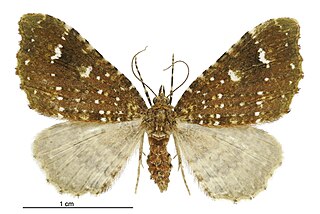Related Research Articles
Copromorpha nesographa is a moth in the Copromorphidae family. It is found on New Ireland.
Rhopalosetia is a monotypic moth genus in the family Copromorphidae. Its only species, Rhopalosetia phlyctaenopa, is found in French Guiana. Both the genus and species were first described by Edward Meyrick in 1926.
Cryptolechia municipalis is a moth in the family Depressariidae. It was described by Edward Meyrick in 1920. It is found in Australia, where it has been recorded from Queensland.
Cryptolechia ichnitis is a moth in the family Depressariidae. It was described by Edward Meyrick in 1918. It is found in French Guiana.
Catacometes hemiscia is a moth in the family Oecophoridae. It was described by Edward Meyrick in 1883. It is found in Australia, where it has been recorded from New South Wales.
Garrha mitescens is a moth in the family Oecophoridae. It was described by Edward Meyrick in 1914. It is found in Australia, where it has been recorded from Queensland and the Northern Territory.
Helcystogramma xerastis is a moth in the family Gelechiidae. It was described by Edward Meyrick in 1905. It is found in Pakistan.
Dichomeris attenta is a moth in the family Gelechiidae. It was described by Edward Meyrick in 1921. It is found in Zimbabwe.
Dichomeris condylodes is a moth in the family Gelechiidae. It was described by Edward Meyrick in 1921. It is found in Zimbabwe.
Dichomeris opsorrhoa is a moth in the family Gelechiidae. It was described by Edward Meyrick in 1929. It is found in South Africa.
Gelechia anomorcta is a moth of the family Gelechiidae. It is found in the Russian Far East and Japan.
Gelechia paraula is a moth of the family Gelechiidae. It was described by Edward Meyrick in 1916. It is found in southern India and Sri Lanka.
Stenoma anetodes is a moth of the family Depressariidae. It is found in Guyana.
Antaeotricha isochyta is a species of moth of the family Depressariidae. It is found in Guyana.
Cerconota rosacea is a moth of the family Depressariidae. It is found in the Amazon region and French Guiana.
Comotechna scutulata is a moth in the family Depressariidae. It was described by Edward Meyrick in 1921. It is found in Brazil.
Moca aphrodora is a species of moth in the family Immidae first described by Edward Meyrick in 1922. It is found in Brazil and Peru.
Moca tormentata is a moth in the family Immidae. It was described by Edward Meyrick in 1921. It is found in the Democratic Republic of the Congo and South Africa.

Asaphodes dionysias is a species of moth in the family Geometridae. This species is endemic to New Zealand. The female of the species has reduced wing size in comparison to the male. It is only known from mountainous areas in Central Otago.

Asaphodes limonodes is a species of moth in the family Geometridae. It is endemic to New Zealand.
References
- ↑ Beccaloni, G.; Scoble, M.; Kitching, I.; Simonsen, T.; Robinson, G.; Pitkin, B.; Hine, A.; Lyal, C., eds. (2003). "Cathelotis sanidopa". The Global Lepidoptera Names Index . Natural History Museum . Retrieved April 28, 2018.
- ↑ Exot. Microlep. 3 (5-7): 242
| This article relating to the superfamily Copromorphoidea is a stub. You can help Wikipedia by expanding it. |